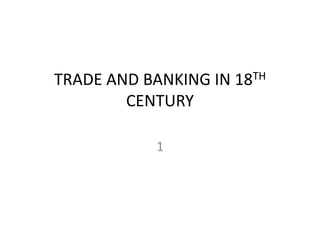
Banking system in mughal india
- 1. TRADE AND BANKING IN 18TH CENTURY 1
- 2. Objective • To know about the nature of the trade and banking system • To know the features of the banking system • To know about the different trade route
- 3. Background • In 18th century India was one of the biggest centres of attraction for trade and commerce all over the World. • There were great flourishing • trade centres • in Lahore, • Agra, • Ahmadabad, • Sironj, • Berhampore, • Dhaka, Patna, • Benares, Golconda, Deccan, Bijapur, and Daulatabad.
- 4. Cont. • Depending on the nature of trade • we can classify these trade centres into two broad categories. • Towns like Peshawar, Lahore, Sirhind, Allahabad, Patna and Qassimbazar (Kassimbazar) prospered because of their close proximity to the national highways or trade-routes.
- 5. Cont. • Secondly towns like Surat, Cambay, Satgaon, Chittagong, flourished because of their location near the sea. • Apart from these towns there were manufacturing centres, each famous for its produce, Dhaka for textile, Patna for saltpetre, Biana and Sarkhel for indigo and so on.
- 6. Trading Commodities • Bengal silk was a very attractive commodity for the Dutch and English traders. • From Central Asia came horses, fruits, slaves, and gorgeous carpets, lavish dress.
- 7. Banking system • hundi network was widespread all throughout the Empire and it could be customized according to need • For example a trader having paid a fixed sum of money to a banker in Surat brings the hundi to Ahmedabad, the banker in the latter place is liable to paid the entire amount. • If the trader wishes to pay his creditors he can hand over the hundi to him and relinquish his obligations. • The man through him all these transactions occurred were called shroffs, they engaged in all sorts of money transfers and issued letter of exchange.
- 8. Cont. • The Dutch East India Company mentions that the commission on hundis in Surat or Ahmedabad to be .62 to 1.25 percent during the 1640’s. • However it was not a fixed rate, in case of turmoil, political or natural disorder the hundi rates varied considerably
- 9. Type of Hundi • In fact we can classify four types of hundis, and all four types were issues by shroffs, they were, • darshani or payable on sight, • miti or payable after date mentioned in the instrument, • shah-jog payable to a respectable man, and • jokhami, sort of risky hundi which covered some elements of insurance. • The Jokhami hundis were drawn against goods dispatched and it contained certain conditions, if the goods are lost or damaged the holder of the hundi had to bear the loss. Payment of such hundis is made on safe receipt of goods and their purchaser act as a sort of insurance agent
- 10. Features of Banking • One of the most important tasks of these shroffs was to understand the value of the money. • all coins struck in the name of the provincial ruler or governor were called sicca. • shroffs could create an artificial scarcity of coins, and dictate the amount of commission at will.
- 11. Cont. • In 18th century Ahmedabad a sudden rise of commission by the shroffs forced the merchants to take up arms against them. • the shroffs had full autonomy in deciding the exchange rates. • the entire money exchange process was complex, and it was designed by the shroffs for their own advantage.
- 12. Cont. • The village level shroffs dealt with labourers, middlemen, various vendors • ADVANCES: • very important feature of a banking sector- Advances or Credit. • Agricultural loans were mainly availed by the peasants, mainly from the village money lenders with high interest rates
- 13. Cont. • Agricultural loans were mainly availed by the peasants, mainly from the village money lenders with high interest rates • Sometimes the state offered the peasants interest free loans, in other times the farmers had to depend mainly on the rural credit suppliers.
- 14. Cont. • Interest rate of unsecured agricultural loans was pretty high as high as 40% and most of the loans to the farmers were unsecured. • High value advances were offered in the form of commercial credits to big merchants and traders. • During the mid seventeenth century the credit interest was usually up to 0.5 to 1.25 percent per month.
- 15. Cont. • To finance distant trade the interest rate sprang up to 40 percent, because of the higher risk involved. • both the high net worth bankers and merchants enjoyed a special privilege in the Mughal court exa-The Surat merchant Rustam Manak
- 16. Cont. • the Best Banker’s Award in that time as well such similar practices existed. • The bankers not only financed the local merchants and Princes, in fact their most valued customers were the foreign traders. • The English, Dutch, French all needed short term loans to meet their financial requirements
- 17. Cont. • In 1720/21 the Company’s debt in Bengal alone was Rs. 2.4 million and in 1747/48 it went up to Rs. 5.5 million.
- 18. Conclusion • the big banks in Mughal Empire was not only a centre of wealth, but also the epicenter of power. • The bankers had established a big control over the highest authority; by their extraordinary power of ‘purchase’ they could ‘buy’ a throne for their preferred candidate.